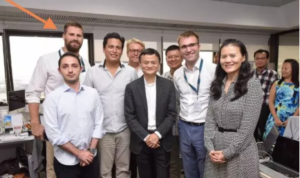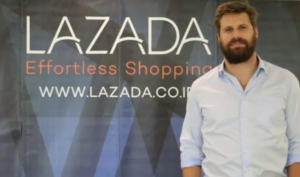
Maximilian Bittner, Lazada’s former CEO, announced his departure from Alibaba on November 13 and would formally assume the CEO of Vestiaire Collective as from January 2019.
Bittner is a key player in Lazada. In 2012, he left McKinsey and joined Rocket Internet in Europe and then went to southeast Asia and set up Lazada. He once managed Lazada’s operations in all six countries it had business at the time, namely, Indonesia, Malaysia, the Philippines, Singapore, Thailand and Vietnam.

Before 2012, Bittner had followed a well-kept path: after graduating from University of London in 2001, he worked as an investment banking analyst at Morgan Stanley for a few years. After receiving MBA from Kellogg School of Management, Northwestern University, Bittner joined McKinsey and became an engagement manager four years later.
If his father had not been an old friend with Oliver Samwer, the founder of Rocket Internet, Bittner might have worked hard to be McKinsey partner.
Rocket Internet began to expand in southeast Asia in 2012. Oliver and his brother Marc (in Europe) scoured for talents with background of business school, investment banking and management consulting. As Bittner met all requirements and was a family friend, he was naturally persuaded to join in.

Rocket Internet was in its prime in 2012. In those years, Lazada was in competition with Zalora, a fashion e-commerce company based in southeast Asia, Jabong, an Indian fashion e-commerce company, Jumia, an African e-commerce company, and Linio, a Latin American e-commerce company.
With existing home e-commerce Home24 and other European businesses such as Westwing, an Internet empire outside China and the United States was taking shape. (Pakistan’s Daraz and other e-commerce weren’t set up until Qatar Telecom and Rocket established a joint venture in Asia.)

How are these companies doing now?
African Jumia raised a lot of money from a group of strategic parties in 2016. Although the African market is still in its early stage, there are recent rumors that Jumia is preparing to go public.
Pakistan’s Daraz was bought by Alibaba this year. The two sides did not disclose the purchase price, but it was expected that the price would not be too high.
Linio was bought in August by Falabella, a Chilean retailer, at $138m.
Zalora, a fashion e-commerce company in southeast Asia, has been shrinking in strategy since 2016. Now, it attracts little attention especially with the rapid financing of its rivals including Zilingo.
In 2014, Jabong was valued at more than 1 billion dollars. It is said that Amazon failed to buy Jabong for nearly 1.2 billion dollars in 2014. But in the end, in 2016, Jabong was acquired by Flipkart, a local e-commerce company, for a “bottom price” of $70 million. (That Flipkart itself was purchased by Walmart at a high price is a later story.)

For a long time, the access control system at Jabong office in Gurgaon, India, was like above.
Namshi is Rocket’s only profitable Middle Eastern e-commerce firm. A property firm owned by Middle Eastern tycoon Alabbar bought 51% of Namshi share. But the dealing had little to do with the performance of Namshi. Alabar raised $1 billion to build Noon, an e-commerce platform. He bought Namshi only for fear that Amazon might buy Namshi to complement Souq’s weakness in fashion.
Lazada, in retrospect, has a pretty good ending, even though it wasn’t bought at a high price. Therefore, Bittner specifically mentioned the acquisition made by Alibaba in his performance statement when assuming a new job.

Alibaba’s troubles
In fact, when Alibaba bought Lazada, it was choosing a general among the dwarfs, just picking the best out of a mediocre bunch. At that time, it seemed that there were many competitors, such as Shopee, Redmart, Zalora, Qoo10, Tokopedia, Tarad, 11 street, EZBuy and so on. But they all operated in a small scale, and their amount of financing was hardly more than $10 million.
Momentum Works believes at that time, it was still too early for anyone to figure out how to operate e-commerce in southeast Asia. Infrastructure was then still in the early stage of construction, the service ecology of e-commerce did not take shape at all, and investment and development became a chicken-and-egg issue.
Among these e-commerce companies, only Lazada, Zalora and Shopee had layout in six countries. Zalora was a fashion e-commerce company, and Tencent was the largest shareholder of Shopee’s parent company, so, Lazada was the only available option that Alibaba had.

As Amazon hadn’t paid attention to southeast Asia, Lazada’s only option was Alibaba. (Of course, JD.com may be a potential buyer, but Richard Liu didn’t have this foresight and could not make up his mind. As a result, JD.com now faces more difficulties in southeast Asia.)
In April 2016, Alibaba took control of Lazada for $1 billion. In March this year, it invested another $2 billion and held 83% of Lazada’s shares. And it also announced that Lucy Peng, chairperson of Ant Financial Group, would become Lazada CEO, and Bittner Maximilian, Lazada’s former CEO, would serve as a senior adviser. So, Bittner was in Lazada for another two years after the purchase.
In 2016, southeast Asia’s e-commerce community wondered if Lazada would undergo a major management shake-up carried out by Alibaba. It didn’t happen because Alibaba doesn’t have enough international core staff to fill these vacancies.

The shortage of talent is a widespread problem in southeast Asian ecommerce community (and even the world), especially when the headquarter is as far away as Germany or China.
Many Chinese Internet companies that expand business in southeast Asia have their R&D teams based in China. The products they design are far away from the needs of local users. Parachuted executives also spend a long time to adapt to local operations. They rarely build trust and effective collaboration with local executives.
What’s more, southeast Asia is not a single market. Policies, regulations, language habits and economic development levels vary greatly from country to country. In some countries, the politics are tricky and changeable, with are pitfalls everywhere. Therefore, there is high demand for talents.Rocket chose to introduce young people who are aggressive, ‘ smart enough and digitally sensitive directly from European and American business schools, investment banks and consultancies. Even so, Rocket has taken a number of detours.

Lazada has already lost a lot of Rocket talent since Alibaba took control of Lazada. This year, Lazada did not seem to maintain its lead in southeast Asia, but was overtaken little by little by Shopee, led by Feng Zhimin, who was born in north of Jiangsu Province. Even though Lucy Peng and her family had moved to southeast Asia.
Can we regard it as Richard Liu’s fellow villager Feng helped Liu win back a game?
Where is Bittner?
Bittner announced that he would take over as Vestiaire Collective CEO from January 2019. It is a Paris-based e-commerce platform for second-hand luxury goods.
France gathers many e-commerce platforms operating second-hand luxury goods, and Vestiaire Collective is one of them. Founded in 2009, the company has raised 116 million euros so far.

Bittner’s task is to extend the business of Vestiaire Collective to emerging markets such as Asia, which sounds daunting.
Second-hand luxury websites are booming in America and Europe. A recent report published by ThredUp predicts that the amount of “resale online” market could reach $41bn by 2022.
But so far, the second-hand luxury goods market is mainly concentrated in European and American countries. Take the Chinese market as an example. It is the largest emerging market, but due to the traditional concept, the second-hand luxury goods trade has been tepid in China, and consumers are more interested in buying a new bag or a new watch rather than hunting for a second-hand one.

How to handle the flood of bad reviews is also a challenge for CEO
Trustpilot is only rated 5.4/10 on VC
InstantLuxe, another French second-hand luxury website, entered China in 2014 with the Chinese name Aiyishe. In 2016, InstantLuxe was acquired by Galeries Lafayette, but it never performed well. Just days earlier, Lafayette announced to close InstantLuxe.
If Vestiaire Collective plans to enter emerging markets, the Middle East may be a good choice. Yoox Net-a-Porter, the world’s largest luxury goods e-commerce company, has set up a subsidiary in partnership with Alabar and entered the Middle Eastern market. This, of course, has to do with the fact that Alabbar himself is a big shareholder in Yoox Net-a-Porter.
As for southeast Asia, it will take a few more years before the e-commerce of second-hand luxury goods has its prime. Or you could learn the development of Reebonz, a Singaporean second-hand luxury e-commerce company.
But perhaps Bittner, who has cashed out of Lazada, is now more strategically patient than when he smashed tables and chairs every week in Lazada?
—
Thanks for reading The Low Down (TLD), the blog by the team at Momentum Works. Got a different perspective or have a burning opinion to share? Let us know at [email protected].










![[New Report] Food delivery platforms in Southeast Asia (SEA) 4.0](https://i0.wp.com/thelowdown.momentum.asia/wp-content/uploads/2024/01/Food-delivery-platforms-in-Southeast-Asia-2024-_MW_Jan-2024-2.jpg?resize=100%2C70&ssl=1)
![[New report] Southeast Asia spends US$3.4 billion on modern coffee in 2023](https://i0.wp.com/thelowdown.momentum.asia/wp-content/uploads/2023/11/Coffee-in-Southeast-Asia_MW_Nov-2023-1.png?resize=100%2C70&ssl=1)
![[New report] Apples to Apples 3.0: Benchmarking major tech platforms – what’s next after achieving profitability?](https://i0.wp.com/thelowdown.momentum.asia/wp-content/uploads/2023/09/Apples-to-Apples-3.0_benchmarking-major-tech-platforms_whats-next-after-profitability_MW_Sept-2023-7.jpg?resize=100%2C70&ssl=1)

![[Press release] Frontline turnover costs businesses US$22.6 billion annually in Southeast Asia: Momentum Works and Lark report](https://i0.wp.com/thelowdown.momentum.asia/wp-content/uploads/2024/07/Transforming-frontline-industries_MWLark_July-2024-6.jpg?resize=100%2C70&ssl=1)
![[New report] Transforming frontline industries](https://i0.wp.com/thelowdown.momentum.asia/wp-content/uploads/2024/07/Transforming-frontline-industries_MWLark_July-2024.jpg?resize=100%2C70&ssl=1)



